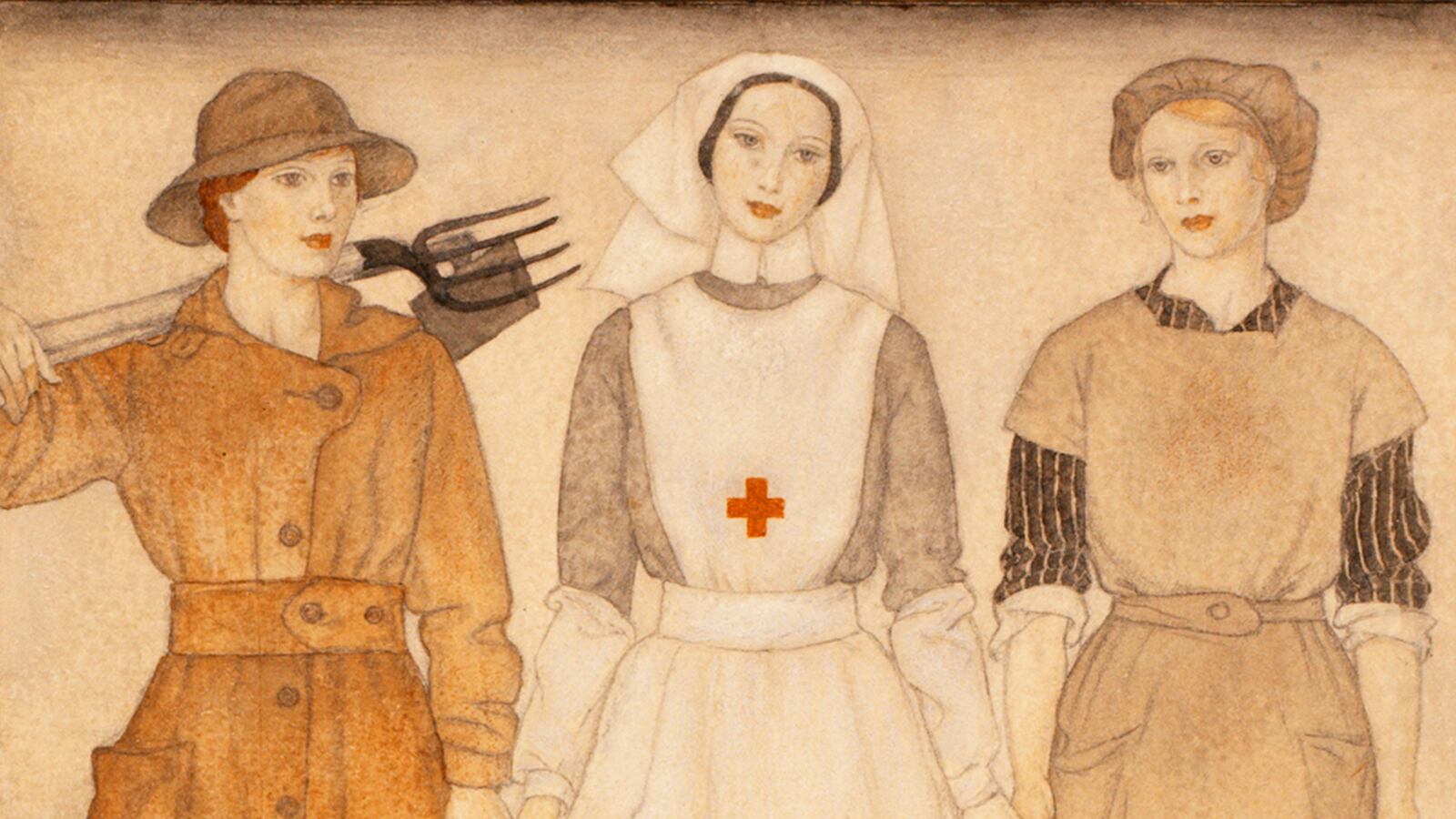Britain entered World War I on August 4, 1914. One hundred years later, the WWI centenary is being honored with a slew of exhibitions and commemorative events, from a light-a-candle hour to memorials for the fallen.

The fashion industry is no exception. Several exhibitions from Britain to New Zealand are spotlighting how the war impacted women’s clothing, from raising hemlines to new utility wear worn by the ladies left at home. Some women even turned to their husband’s closets to dress themselves for their new occupations supporting the home front.
"As the men left for war, women took on what were previously male-dominated roles such as farm or factory work. The physicality of the work meant that traditional women’s attire wasn’t appropriate. Women raided men’s wardrobes and altered shirts and trousers to fit,” says Doris de Pont, curator of The Way We Wore—In Service and On The Street, an exhibition opening at the online New Zealand Fashion Museum on Tuesday.
At the Bath Fashion Museum, meanwhile, The Great War in Costume: Family & Fashion on the Home Front is running until August 31 and displays around two-dozen wartime costumes, including a dozen looks from the PBS series Downtown Abbey, which is set during WWI. The exhibition includes uniforms and civilian dress, memorabilia, and propaganda items that show how, once the war started, it was time for women to begin wearing trousers.

“World War One changed the lives of women for ever due to the recruitment of most healthy men,” Yvonne Hellin-Hobbs, the exhibition’s organizer, says. “With this, women’s fashion changed; corsetry was softened and clothing became more practical, with some working women even wearing trousers for the first time.”
The Bath exhibition used British journalist Kate Adie’s publication Fighting on the Home Front: The Legacy of Women in World War One for inspiration. In the book, Adie shows how women “emerged from the shadows of their domestic lives and took up essential roles—from transport to policing, munitions to sport, entertainment, and even politics. They became citizens in their own right and helped win the war,” as per the official blurb on the book.
The New Zealand exhibition, on the other hand, relied on the general public to assemble its show.

The Way We Wore exhibits around 60 photographs from World War I and World War II gathered through an open call to New Zealanders and presents them with their associated stories. (A selection of the images is also being published this week in Glory Days magazine.)
These photographs were taken from the “attics and old suitcases of New Zealanders.” “The images show how real people dressed and interacted at the time, and the impact of the war years on our sartorial style,” De Pont says. “As the centenary of the beginning of WWI draws close, we felt it was a time to reflect on what life was like not only for soldiers and those involved on the battlefield, but also for people who kept the home fires burning during very trying times.”
The impact of World War I and II can be seen both in the practical construction of garments and the inventive use of the limited materials at hand. “Fashion, as we think of it, was all but suspended during the war years not just ‘over there’ but on the home front too,” De Pont says.
With rationing in full force during those years, De Pont was interested in seeing “how restrictions in materials manifested themselves in creative and thrifty ideas for civilian dress as well as uniforms.”
Think hemlines that rose during the conflict, and then fell again as the war came to a close.

Prior to the war, New Zealand was prospering in its role as “Britain’s Farm,” and women in particular, according to De Pont, were attuned to the latest fashions from London and Paris.
But New Zealand and Australia were particularly hard hit by the war. “After the Gallipoli campaign was not only a resounding defeat for the Allies but also resulted in the decimation of the New Zealand contingent sent to participate, with a casualty rate of an astonishing 88 percent of their troops dead or wounded. With a population of only 1 million in 1914, this and the subsequent disproportionate and heavy losses at the Western Front meant that every New Zealander at home was affected directly or indirectly by this war,” De Pont says.
Fashion reflected these losses.
“Ostentatious dress was considered inappropriate even where people had the means. Sober and muted colors including shades of gray, one described in a local paper as ‘Battleship,’ were prevalent. Jewelry and other showy decorative elements were put aside,” De Pont says.
But the war also helped modernize women’s dress.
“Women gained a great deal of freedom during wartime. They were reluctant to return to pre-war gender definitions, including the definition of what was proper for a woman to wear,” De Pont explains. “In the post-war years in New Zealand, as elsewhere, many young women were reluctant to pull back from an active life outside the home and to demure to the constraints of domesticity and corseted fashions. Luckily, fashion too had moved on and in the immediate post-war period the gamine look emerged, unstructured it was made for freedom and action. Vibrant color surfaced in textile and in beading and embroidery. All over the world following the fashion of Paris and London became fashionable again.”
But Paris was no longer the only guide post for what was en vogue. New York took over as the epicenter of fashion due to the difficulties communicating with France during the war. The Big Apple influenced the industry by introducing a more practical look combined with the existing femininity.
The war’s influence on designers was lasting, even having an impact on some collections seen on the runway today.
When New York-based designer Thom Browne sent out his latest menswear collection in Paris in June, guests arrived to find what looked like rows of WWI soldiers in gray uniforms, sitting motionless with plasters over their eyes, as his latest designs were paraded around the ominous setting, in a rare runway reference to the centenary.






